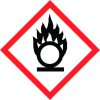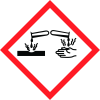Ácido nitrico 65% p.a. EMSURE Reag. Ph
Merck S.A. VE
Fecha de revisión: : 2021-08-21



Información General
Fecha de revisión:
2021-08-21
Nombre del producto
Ácido nitrico 65% p.a. EMSURE Reag. Ph
Número CAS
7697-37-2
REACH Número de registro
Este
Uso recomendado:
Análisis químico, Producción química
Número de emergencia
900-868538 (CHEMTREC España
IÍconos en FDS
Información de la empresa
Empresa
Merck S.A. VE
Información GHS
Palabra clave
Peligro
Hazard Codes
Declaraciones de peligro (CLP)
H272, H290, H314, H318, H331
Declaraciones de peligro
Código
Declaraciones
H272
May intensify fire; oxidiser
H290
May be corrosive to metals
H314
Causes severe skin burns and eye damage
H318
Causes serious eye damage
H331
Toxic if inhaled
Consejos de prudencia
Código
Declaraciones
P210
Keep away from heat, hot surface, sparks, open flames and other ignition sources. - No smoking.
P220
Keep away from clothing and other combustible materials.
P280
Wear protective gloves/protective clothing/eye protection/face protection.
P303+P361+P353
IF ON SKIN (or hair): Take off Immediately all contaminated clothing. Rinse SKIN with water [or shower].
P305+P351+P338
IF IN EYES: Rinse cautiously with water for several minutes. Remove contact lenses if present and easy to do - continue rinsing.
Declaraciones EUH
Código
Declaraciones
EUH071
Corrosive to the respiratory tract
Sección 2
SECCIÓN 2: Identificación de los peligros
No 1272/2008 Classification of the substance or mixture Classification according to Regulation (EC) No 1272/2008 Oxidizing liquids (Category 3), H272 Corrosive to Metals (Category 1), H290 Acute toxicity, Inhalation (Category 3), H331 Skin corrosion (Sub-category 1A), H314 Serious eye damage (Category 1), H318 For the full text of the H-Statements mentioned in this Section, see Section 16. 2.2 Label elements Labelling according Regulation (EC) No 1272/2008
Pictogramas de peligro
Signal word Danger Hazard statement(s) H272 May intensify fire; oxidizer. H290 May be corrosive to metals. H314 Causes severe skin burns and eye damage. H331 Toxic if inhaled. Precautionary statement(s) P210 Keep away from heat, hot surfaces, sparks, open flames and other ignition sources. No smoking. P220 Keep away from clothing and other combustible materials. P280 Wear protective gloves/ protective clothing/ eye protection/ face protection/ hearing protection. P303 + P361 + P353 IF ON SKIN (or hair): Take off immediately all contaminated clothing. Rinse skin with water. P304 + P340 + P310 IF INHALED: Remove person to fresh air and keep comfortable for breathing. Immediately call a POISON CENTER/ doctor. P305 + P351 + P338 IF IN EYES: Rinse cautiously with water for several minutes. Remove contact lenses, if present and easy to do. Continue rinsing. Supplemental Hazard information (EU) EUH071 Corrosive to the respiratory tract. Etiquetado reducido (<= 125 ml)
Indicaciones de peligro
H331 Tóxico en caso de inhalación. H314 Provoca quemaduras graves en la piel y lesiones oculares graves. Declaración(es) de prudencia P280 Llevar guantes/ ropa de protección/ equipo de protección para los ojos/ la cara/ los oídos. P303 + P361 + P353 EN CASO DE CONTACTO CON LA PIEL (o el pelo): Quitar inmediatamente toda la ropa contaminada. Enjuagar la piel con agua. P304 + P340 + P310 EN CASO DE INHALACIÓN: Transportar a la persona al aire libre y mantenerla en una posición que le facilite la respiración. Llamar inmediatamente a un CENTRO DE TOXICOLOGÍA/ médico. P305 + P351 + P338 EN CASO DE CONTACTO CON LOS OJOS: Enjuagar con agua cuidadosamente durante varios minutos. Quitar las lentes de contacto cuando estén presentes y pueda hacerse con facilidad. Proseguir con el lavado. Información suplementaria sobre riesgos (UE) EUH071 Corrosivo para las vías respiratorias.
2.3. Otros riesgos
Esta sustancia/mezcla no contiene componentes que se consideren que sean bioacumulativos y tóxicos persistentes (PBT) o muy bioacumulativos y muy persistentes (vPvB) a niveles del 0,1% o superiores.

